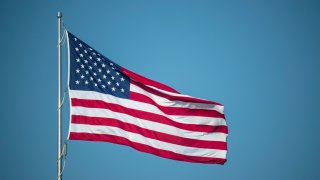
Every American athlete and sports connoisseur recognizes the significance of a single song when it comes to sporting events - whether that game be on ice, on a field, or on a court.
The Star-Spangled Banner, otherwise known as the national anthem, is an ode to history and a tradition carried out across the entire country.
Watch NBC6 free wherever you are
The national anthem is either played or sung prior to any athletic event in the U.S. - ranging from the NFL, MLB, NBA, NHL, NCAA, all other professional leagues and usually including most high school-level sports as well. The song is a preface to the athleticism about to take place, but also a way in which we honor our country and those who framed our nation.
But who decided that the Star-Spangled banner would be the nation’s song? And why is it prevalent in sporting events in particular?
Get local news you need to know to start your day with NBC 6's News Headlines newsletter.
Here’s everything you need to know about the history of the national anthem:
What is the history of the national anthem?
The Star-Spangled Banner is the national anthem for the United States and it was formally written by Thomas Carr.
The lyrics derive from the “Defence of Fort McHenry” poem, which dates back to 1814.
The prose was written by poet Francis Scott Key after he watched the tragedy at Fort McHenry by British ships in Baltimore Harbor in the Battle of Baltimore during the War of 1812. The inspiration drew from the U.S. flag waving high and mighty upon victory with its 15 stars and 15 stripes. The flag was known as the Star-Spangled Banner.
When was the Star-Spangled Banner recognized as the national anthem?
The Star-Spangled Banner was recognized for its official use in the U.S. Navy by President Woodrow Wilson in 1916. The song was deemed the American national anthem through a congressional resolution that President Herbet Hoover signed in 1931.
What was the US national anthem before 1931?
Before the Star-Spangled Banner became the American national anthem in 1931, other songs including “America the Beautiful,” “Hail, Columbia,” and “My Country, Tis of Thee,” were used to honor the nation.
Why is the national anthem sung at sporting events?
The Star-Spangled Banner is played or performed for thousands of sporting events each year, ranging from high school soccer games, to college basketball games, and of course in professional leagues like the NFL. The Super Bowl has been entertaining the song since its first game in 1967, and will do so for all of the coming years.
But why is this song so monumentally necessary to be heard before kick-off, face-off, or tip-off?
The song was published country-wide in the 1800s and became a “wartime anthem.” It was played during patriotic celebrations and parades, much like those held on Independence Day. And soon after, Benjamin J. Tracy, the Secretary of the Navy, signed General Order #374 in 1889, which declared the Star-Spangled Banner to be the song played whenever the U.S. flag was raised.
The anthem was not required to be played in athletic atmospheres until later, but the song became popular in the 1800s and began being presented before games.
Once victory was evident during World War I for the U.S. and its allies, patriotism soared. Sporting events became the perfect place for the song to reach audiences and promote U.S. allegiance and loyalty.
When did the national anthem start in sports?
The song made headway during the 1918 World Series when the Chicago Cubs faced the Boston Red Sox (and yes, Babe Ruth was present). When the Star-Spangled Banner played during the seventh inning stretch, a sports tradition was born.
The national pride demonstrated in the 2-3 minutes of the song was uncanny, and from then on, sports and country became intertwined into American culture.



